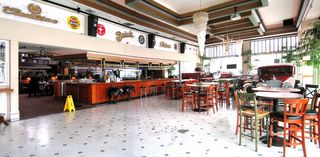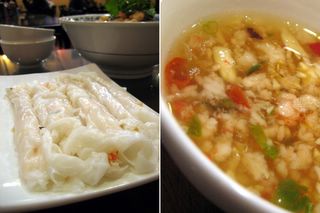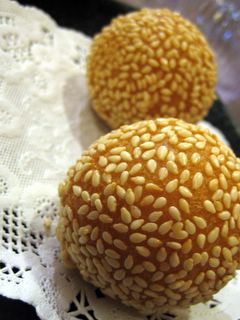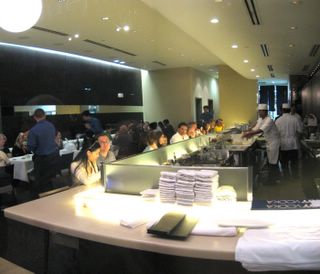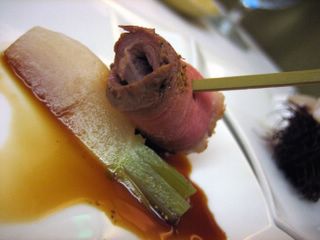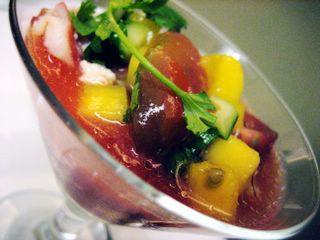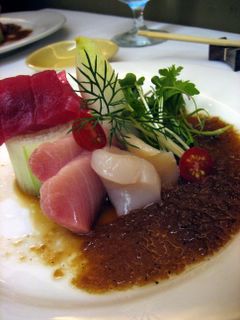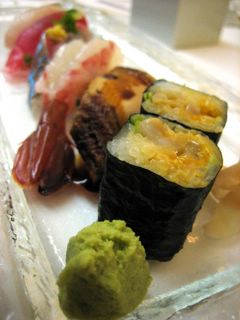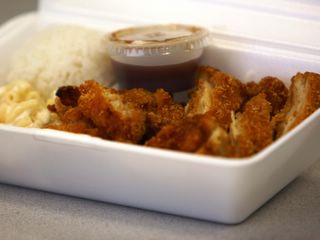
If
The French Laundry is my
Everest,
Spago is my
K2.
As such, when I was asked what restaurant I'd like to be treated out to for my birthday, I quickly replied, "The tasting menu at Spago" since it required nothing more than a reservation and a full tank of gas (for my
second trip to L.A. proper in a year)...and oh yeah, oodles of cash.
In case you're keeping track: yes, this is the second birthday meal to occur after the blow-out at
Bluefin a week prior.
And in case you're wondering: yes, when my generous and wonderful dining companions' birthdays come around, I plan to return the gesture in spades.
But still, out of sheer guilt, and to set the bar so that I may clear it myself when that time comes, I chose
Spago's less expensive lunch tasting menu, which by the way, already runs $80 per person (before tax and an additional 20% service fee).
The expense is not surprising when you realize this is the same
Spago where Elton John hosts his Oscar parties; the same
Spago which is the flagship of the Wolfgang Puck empire; the same
Spago which is #4 on
Gourmet Magazine's Top 50 Restaurants in the U.S.; and the same
Spago which won a
James Beard Award last year.
And let's not forget:
IT'S IN BEVERLY HILLS!
But despite the formidable credentials and the 90210 ZIP code, not once during our Saturday lunch did we feel out of place. The staff couldn't have been more cheerfully accommodating, and we couldn't have felt more comfortable and welcome.
Even pastry chef,
Sherry Yard, came out to chat and asked how we enjoyed the meal.
Everyone we interacted with was professional but not stuffy. And since the tasting menu demands full-service, no less than three servers doted on us, explained the dishes, refilled our drinks, and replaced the silverware and china. They not only used
crumb scrapers, but also gleaming
silver-plated food domes which kept hot dishes hot until it was lifted off with a flourish in front of us.
While the service staff put us at ease, the kitchen staff had us on our toes. Their creativity was revving at full bore, and their desire to impress, challenge, and beguile was palpable at every turn; from the
amuses to the
petits fours.

The first
amuse bouche emulated one of
The French Laundry's signature items; the tuna tartare cone. Chopped raw tuna, laced with a stinging pepper sauce, was scooped into a miniature cone dotted with black-sesame seeds. Bonito flake streamers completed this whimsical nod to
Baskin-Robbins.
Although the tuna sparkled, it was the cone that dazzled. Simultaneously savory and sweet, it resembled Chantilly lace woven from spun sugar.

The second
amuse, was a bite-sized curl of salmon, lightly peppered, studded with onion, and topped with salmon eggs. It rested on a pillow-soft blini.
The chilled fish was the perfect foil to the airy warmth of the pancake; but it was the herby hit of dill which punctuated the luscious
hor d'oeuvre, and whetted our appetites for more.
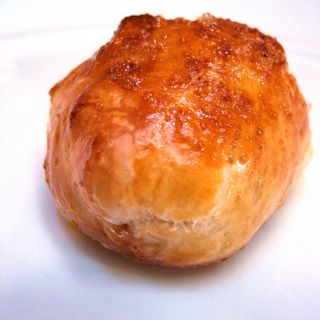
For the last
amuse, a baked orb of feather-light puff pastry hid a buttery center of bacon fat. They called it
Bacon Confit en Croute; I called it the
Coronary Cloggin' Cream Puff.
Thankfully, there was only one per person, or else I would have gorged myself until I keeled over from heart failure -- with my hands clutched to my chest -- dead with a smile frozen on my face.

The basket of bread featured towering triangles of
lavash, arranged to look like the tentacles of the
Kraken reaching up from the depths.
Singed on its fringes from the fires of the oven, the crackers shattered into jagged pieces when bitten, and tasted like
Wheat Thins on crack.
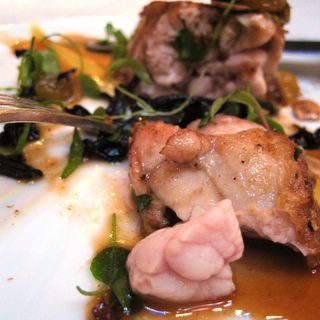
The first course went for the gut, literally, and set the tone for the rest of the meal. It was a message from the kitchen: "You asked for a tasting menu; we're going to give you one."
Veal sweetbreads, a euphemism for "pancreas of a young cow," sounded harmless enough for my dining companions, who were blissfully unaware of this fact.
I waited until they finished their plates before I informed them of what they had consumed. Thankfully, neither blinked when I did, which was both a testament to their open minds and how well the kitchen prepared the nasty bits.
Seared and paired with a tangerine
gastrique, the spongy white lobes squished beneath our teeth, sublimely soft, like a meat marshmallow. The acidic sauce helped to tame the milky richness of the organ and temper the offal funk.

The next course was less exotic but just as ambitious. Maryland blue crab, sea urchin roe, and
Matsutake mushrooms are cooked simply, then bathed with a
mascarpone emulsion.
The sweet morsels of the crustacean mingled with sea urchin roe, which burst with a sea-salty tang of their own. The
Matsutake mushrooms, exhibiting something the Japanese call
umami, countered the cheesy creaminess and foam of the
mascarpone.
This slobbery mess of a dish worked despite the fact that
mascarpone, Italian cream cheese, is normally relegated to
tiramisu.

The
agnolotti, mini-purses of pasta resembling
ravioli, oozed a buttery filling while sugary corn nibblets contributed texture. But the white truffles, which adorned the top in generous razor thin shavings, did not stand a chance from the flavor assault of the other two ingredients.
Its subtlety was lost, but not missed. Although the fact that its was there in the first place justified how much this meal was going to cost.

For the next course, skate was pan fried, and done up Indian style, with lentils and two kinds of chutney; mint and tamarind. The former scorched and cooled the tongue, while the latter tasted vaguely of prunes.
The combined effect was aggresive; a frontal attack on the mouth and sinus. It was almost too much for the delicate meat of the stingray to bear. But the striated flesh held its own with a bouncy and plump texture somewhere between lobster and trout, pulling apart in clean strips.

The last savory dish was also our least favorite. Roasted squab (yes, pigeon), was served provocatively, with the toes and feet still attached to the drumstick, and its
talons curled-up in unimaginable anguish.
Next to it, the rare, bloody chunks of the breast looked tender but gnawed stubbornly like stale chewing gum. Making matters worse was the subcutaneous membrane separating skin and meat, which stretched like latex and contributed even more chewiness.
The whole thing also stunk of Chinese
five-spice powder, which amped up the gamy flavor of the squab tenfold, and clashed with the drizzled port wine sauce.
In keeping with the Chinese theme, a side dish of stir-fried
haricot verts and okra was slathered with oyster sauce. But this too was heavy-handed, and a chore to eat.

A wedge of runny cheese signaled the impending close of our lunch. The name of the sample escapes me, but it came with a rind covered in ash, and a taste reminiscent of
brie with the slight medicine tang of
bleu.
We spread the cheese on toasted raisin bread and spooned a touch of the berry marmalade. What we couldn't scrape with our knives, we pinched off with our fingers, leaving behind a clear sign that we enjoyed the dish -- napkins streaked with black soot.
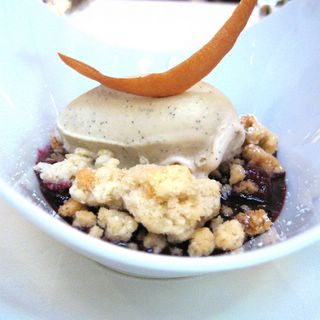
For dessert, the warm berry crumble was presented in a boomerang-shaped bowl and a crowned with a scoop of "fifty vanilla bean ice cream."
The ice cream disappeared too quickly, and left us to finish a half bowl of the lip-puckeringly tart compote alone, without it.

Just when we thought it was all over,
petits fours graced our table. The five delectable mini confections -- decorated in fondant, chocolate and cocoa dust -- promised teeth-rotting delights and delivered.
Our favorite by far was the chocolate cube, with a top lid composed of round chocolate pellets. Our server was instructed by the pasty chef to tell us to pop the entire piece in our mouths, lest we wanted chocolate sauce to squirt out and onto our shirts. Heeding the advice, we did so and felt the gush of liquid as soon as our teeths punctured the thin chocolate shell. The rush of chocolatey goodness made us giggle as only chocolate could.
The same instructions applied to the lemon "gusher", and when we ate it, it tickled us just the same.
My culinary K2 conquered, only Everest remains. And if you ask why, I'll answer, "
Because it's there."
Spago(310) 385-0880
176 N Canon Dr
Beverly Hills, CA 90210
